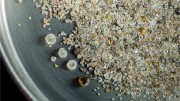In January, mine-finder Chuck Fipke was inducted into the Canadian Mining Hall of Fame.
Fipke’s hard work, perseverance and innovative exploration techniques led to the discovery of Canada’s first diamond mine, Ekati, in the Northwest Territories.
Before the 1991 discovery by Fipke and his partner at Dia Met Minerals, Stu Blusson (each owns a 10% stake in Ekati), there were few who believed a diamond mine in Canada would be a reality.
But the discovery spawned a staking rush in the north and the start of a new industry for Canada.
Ekati started production in 1998, and today, Canada is the world’s third-largest producer of diamonds by value.
Born in Edmonton, Fipke studied geology at the University of British Columbia. After graduating in 1970, he travelled the world working for major companies such as Kennecott and Cominco.
During that time, he developed an interest in heavy mineral geochemistry. Back in Canada in 1977, he established his own lab specializing in processing heavy mineral samples: C.F. Mineral Research, in Kelowna, B.C.
Fipke soon became involved in diamond exploration in northern Canada through Superior Oil, and then with Dia Met Minerals, a company he founded in 1982 with Blusson, a fellow geologist.
Early on, the partners heard that De Beers was exploring at Blackwater Lake in the Northwest Territories and started to stake claims in the area, where they found diamond indicator minerals.
“In working the claims, we realized basically that the indicator minerals there must have been brought in through glaciation,” Fipke said in a video presentation before the induction. “And the more we sampled eastward, we kept finding indicators in the tills.”
This detective work led to a joint-venture deal with BHP Minerals in 1990, thanks to the late BHP geologist Hugo Dummett (inducted in 2010), and the pivotal Ekati discovery at Lac de Gras one year later.
C.F. Mineral Research became and remains a leading processing facility in the world of diamond exploration, and Fipke published the first guide to diamond exploration using indicator mineral geochemistry in 1995.
Born with a sense of adventure, Fipke worked in far-flung regions of Papua New Guinea, Brazil and South Africa during his career, as well as the Arctic. While he had some close calls, including surviving cerebral malaria and a helicopter crash, Fipke confessed in the video presentation that he doesn’t fear anything.
“It’s crazy,” he said. “I should fear more.”
Stepping up to the podium to accept his award, however, Fipke admitted that “I do fear one thing, and that’s what I’m about to say — in front of all these people, it is a little scary.”
Visibly overwhelmed by the honour, Fipke thanked those who nominated him and explained that he hadn’t realized he was worthy of the Hall of Fame.
“I always thought you’d need to find at least two to three mines in order to get inducted!” he said to applause and laughter.
Touting the Ontario and Yemen-based projects being advanced through his current company, Metalex Ventures (MTX-V), Fipke added: “Maybe I’ll redeem myself and make up my deficit.”
Fipke acknowledged that the key to making the Ekati discovery was a top-notch team that included Blusson, Dummett, John Gurney and many others. He also thanked his mother, who was in the audience.
Notably, Fipke affirmed that money has never been the driver behind his thirst for discovery.
“Just about every geologist and prospector knows what I’m talking about: the find,” he said. “You want to discover, it’s what you were trained to do and that’s what you want to do.”
— The preceding is an excerpt from a story originally published in The Northern Miner.




Be the first to comment on "Chuck Fipke joins the Canadian Mining Hall of Fame"